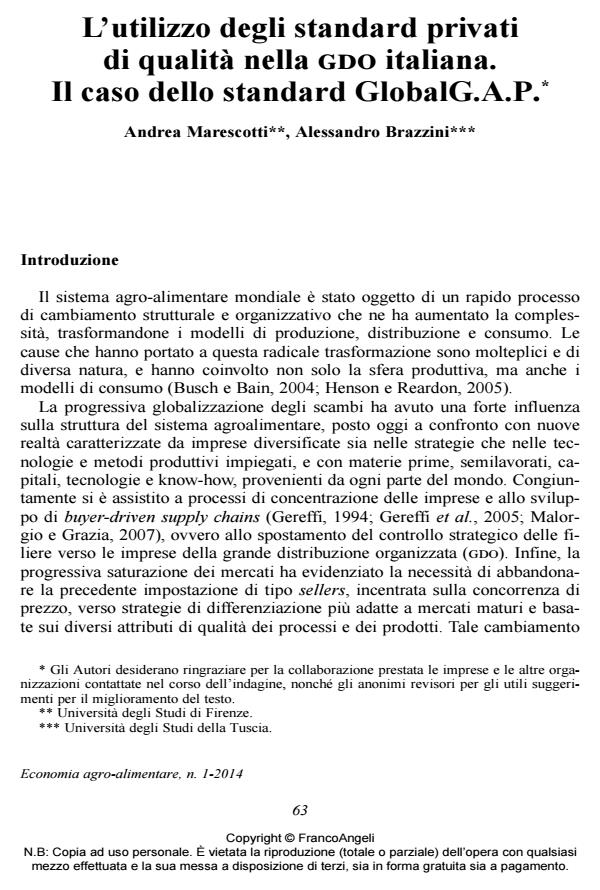The use of voluntary quality standard by Italian large retail chains. The case of GlobalG. A.P. standard
Journal title ECONOMIA AGRO-ALIMENTARE
Author/s Andrea Marescotti, Alessandro Brazzini
Publishing Year 2014 Issue 2014/1
Language Italian Pages 21 P. 63-83 File size 74 KB
DOI 10.3280/ECAG2014-001004
DOI is like a bar code for intellectual property: to have more infomation
click here
Below, you can see the article first page
If you want to buy this article in PDF format, you can do it, following the instructions to buy download credits

FrancoAngeli is member of Publishers International Linking Association, Inc (PILA), a not-for-profit association which run the CrossRef service enabling links to and from online scholarly content.
Voluntary standards have gained in importance all over the world. The choice to set-up voluntary standards and their consequent widespread application came from the private stakeholders’ need to gain the trust and increase the security on the part of consumers and agro-food actors. In particular, it was a result of the negative effects caused by several food scares and the public’s difficulty in reacting promptly and efficiently to agro-food changes. Since the late 1980s, this process has been growing significantly. As a result, the setting-up of significant numbers of standards and the wide-range they cover has mirrored an ongoing transformation in food safety and food quality management among international agro-food chains. The main goal of this paper is to analyze the reasons for the wide diffusion of private standards schemes within the Italian retail market as well as obstacles it faces through the study of the Global-Gap standards case. Global-Gap is a private sector body that proposes voluntary standards for the certification of agricultural production processes around the world. Unlike other standards, Global-Gap has succeeded in establishing itself as a leader, both in Europe and all around the world. Nonetheless, Global-Gap’s geographical distribution is not homogeneous either across territories or in firms’ business strategies. The survey helped to explain the particular Italian paradox, which, on the one hand, shows a large number of farms implementing the Global-Gap standard, but, on the other hand, its relatively infrequent use by retailers operating in Italy when accrediting upstream actors. North European retailers, in contrast, adopt this standard as a sort of passkey for fruit and vegetable producers.
Keywords: Quality standard, Global-Gap, mass distribution, Italy
Jel codes: Q13, L15
Andrea Marescotti, Alessandro Brazzini, L’utilizzo degli standard privati di qualità nella gdo italiana. Il caso dello standard GlobalG.A.P. in "ECONOMIA AGRO-ALIMENTARE" 1/2014, pp 63-83, DOI: 10.3280/ECAG2014-001004